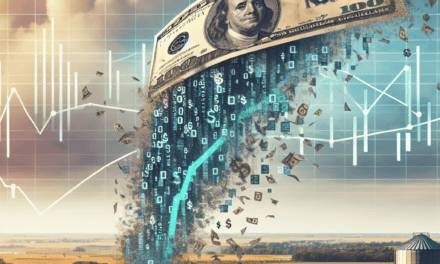“Gold Loses Luster: Post-Election Selloff Sparks Price Dip”
Introduction
Gold prices have experienced a notable decline as part of a broader post-election selloff, reflecting heightened market volatility and investor uncertainty. Following the recent electoral outcomes, financial markets have been adjusting to potential shifts in economic policy and geopolitical dynamics, prompting a reevaluation of asset allocations. Traditionally viewed as a safe-haven asset, gold has seen its allure diminish temporarily as investors pivot towards riskier assets or liquidate holdings to cover losses elsewhere. This downturn in gold prices underscores the complex interplay between political events and market sentiment, highlighting the precious metal’s sensitivity to broader economic and financial trends.
Impact Of Political Uncertainty On Gold Prices
The recent decline in gold prices has captured the attention of investors and analysts alike, as the precious metal, often considered a safe haven during times of uncertainty, has experienced a notable downturn amid the ongoing post-election selloff. This phenomenon can be largely attributed to the political uncertainty that has gripped markets, influencing investor behavior and, consequently, the valuation of gold. As political landscapes shift, the impact on financial markets becomes increasingly pronounced, with gold prices serving as a barometer for investor sentiment.
Political uncertainty often leads to heightened volatility in financial markets, as investors grapple with the potential implications of new policies and leadership changes. In the wake of elections, particularly those with contentious outcomes or unexpected results, market participants may reassess their portfolios, seeking to mitigate risk. Traditionally, gold has been perceived as a hedge against such uncertainty, providing a stable store of value when other assets appear vulnerable. However, the current decline in gold prices suggests a more complex interplay of factors at work.
One contributing factor to the recent selloff is the strengthening of the U.S. dollar, which often moves inversely to gold prices. As political developments unfold, the dollar’s performance can be influenced by expectations of future economic policies, interest rate adjustments, and overall market confidence. A stronger dollar makes gold more expensive for holders of other currencies, thereby reducing demand and exerting downward pressure on prices. This dynamic underscores the interconnectedness of global financial markets and the multifaceted nature of gold’s role within them.
Moreover, the post-election period is frequently characterized by shifts in fiscal and monetary policy expectations. Investors may anticipate changes in government spending, taxation, and regulatory frameworks, all of which can have significant implications for economic growth and inflation. In such an environment, the appeal of gold as an inflation hedge may be reassessed, particularly if market participants believe that new policies will effectively manage inflationary pressures. Consequently, the perceived need for gold as a protective asset may diminish, contributing to its price decline.
Additionally, the behavior of institutional investors can amplify trends in gold prices. Large-scale asset managers and hedge funds often adjust their positions in response to political developments, either by reallocating assets or engaging in speculative trading. These actions can create momentum in the market, further influencing gold prices. As these investors react to the evolving political landscape, their decisions can have a cascading effect, impacting retail investors and shaping broader market sentiment.
It is also important to consider the role of geopolitical tensions in the current environment. While domestic political uncertainty is a significant factor, international relations and conflicts can also affect gold prices. In times of heightened geopolitical risk, gold may experience increased demand as a safe haven asset. However, if such risks are perceived to be contained or mitigated, the urgency to hold gold may wane, contributing to price fluctuations.
In conclusion, the decline in gold prices amid the ongoing post-election selloff highlights the intricate relationship between political uncertainty and financial markets. As investors navigate this complex landscape, their perceptions and expectations regarding future political and economic developments will continue to shape the demand for gold. Understanding these dynamics is crucial for market participants seeking to make informed decisions in an ever-evolving environment.
Historical Trends: Gold Prices After Elections
In the aftermath of elections, financial markets often experience a period of volatility as investors react to the outcomes and adjust their portfolios accordingly. This phenomenon is not new, and historical trends reveal that gold prices, in particular, tend to fluctuate significantly during these times. The recent decline in gold prices amid the ongoing post-election selloff is a testament to this pattern, reflecting broader market sentiments and investor behavior.
Historically, gold has been perceived as a safe-haven asset, a reliable store of value during times of uncertainty. This perception is rooted in gold’s intrinsic value and its ability to retain worth even when other assets falter. However, the post-election period often brings about a unique set of circumstances that can influence gold prices in unexpected ways. For instance, the outcome of an election can lead to shifts in fiscal and monetary policies, which in turn affect inflation expectations and interest rates—two critical factors that impact gold prices.
In examining past elections, it becomes evident that gold prices do not always follow a predictable path. For example, after the 2008 U.S. presidential election, gold prices initially rose as the financial crisis deepened, prompting investors to seek refuge in the precious metal. Conversely, following the 2016 election, gold prices experienced a sharp decline as markets reacted to the prospect of economic growth and rising interest rates under the new administration. These examples illustrate that while gold is often seen as a hedge against uncertainty, its price movements are also influenced by broader economic expectations and investor sentiment.
The current decline in gold prices can be attributed to several interrelated factors. Firstly, the post-election environment has been characterized by a shift in investor focus towards riskier assets, such as equities, driven by optimism about potential economic policies and growth prospects. This shift has led to a reallocation of capital away from safe-haven assets like gold, contributing to the downward pressure on prices. Additionally, the anticipation of changes in monetary policy, particularly the possibility of interest rate hikes, has further dampened gold’s appeal. Higher interest rates increase the opportunity cost of holding non-yielding assets like gold, making them less attractive to investors.
Moreover, the strength of the U.S. dollar plays a crucial role in determining gold prices. As gold is priced in dollars, a stronger dollar makes gold more expensive for foreign investors, thereby reducing demand. In the current scenario, the dollar has gained strength amid expectations of tighter monetary policy, exacerbating the decline in gold prices.
While the immediate post-election period often brings about volatility in gold prices, it is essential to consider the long-term perspective. Historically, gold has demonstrated resilience and the ability to recover from short-term fluctuations. Investors with a long-term outlook may view the current decline as a buying opportunity, banking on gold’s enduring value and its role as a hedge against future uncertainties.
In conclusion, the decline in gold prices amid the ongoing post-election selloff is consistent with historical trends observed after previous elections. While short-term factors such as shifts in investor sentiment, monetary policy expectations, and currency fluctuations have contributed to the current downturn, the long-term fundamentals of gold remain intact. As history has shown, gold’s allure as a safe-haven asset endures, even as it navigates the complexities of post-election market dynamics.
Investor Sentiment And Its Effect On Gold Market
In the wake of the recent elections, investor sentiment has played a pivotal role in shaping the dynamics of the gold market. The decline in gold prices, observed amid the ongoing post-election selloff, underscores the intricate relationship between investor behavior and commodity markets. As investors reassess their portfolios in response to the evolving political landscape, the gold market has experienced notable fluctuations, reflecting broader economic sentiments and expectations.
To understand the current decline in gold prices, it is essential to consider the factors influencing investor sentiment. Political events, such as elections, often introduce a degree of uncertainty that can lead to volatility in financial markets. In this context, gold, traditionally viewed as a safe-haven asset, typically attracts investors seeking stability. However, the recent selloff suggests a shift in investor priorities, possibly driven by a combination of factors including anticipated policy changes, economic forecasts, and shifts in risk appetite.
One significant factor contributing to the decline in gold prices is the strengthening of the U.S. dollar. Historically, gold prices tend to move inversely to the dollar; as the dollar appreciates, gold becomes more expensive for holders of other currencies, thereby reducing its appeal. The post-election period has seen a rally in the dollar, fueled by expectations of economic growth and potential interest rate hikes. This has, in turn, exerted downward pressure on gold prices, as investors pivot towards assets that may offer higher returns in a strengthening economic environment.
Moreover, the equity markets have shown resilience and growth in the aftermath of the elections, drawing investor attention away from gold. The prospect of favorable economic policies and fiscal stimulus has bolstered confidence in equities, leading to a reallocation of assets. As investors seek to capitalize on potential gains in the stock market, the demand for gold as a hedge against uncertainty diminishes, contributing to its price decline.
In addition to these economic factors, psychological elements also play a crucial role in shaping investor sentiment. The perception of stability or instability in the political arena can significantly influence market behavior. In the current scenario, the election results have been perceived by some investors as a harbinger of stability, prompting a shift away from traditional safe-haven assets like gold. This perception, whether accurate or not, can have a profound impact on market dynamics, as collective investor actions drive price movements.
Furthermore, the global economic context cannot be overlooked when analyzing the gold market. International developments, such as trade relations and geopolitical tensions, continue to influence investor sentiment and, by extension, gold prices. In a globalized economy, the interconnectedness of markets means that domestic political events can have far-reaching implications, affecting investor behavior worldwide.
In conclusion, the decline in gold prices amid the ongoing post-election selloff highlights the complex interplay between investor sentiment and market dynamics. As investors navigate the post-election landscape, their perceptions and expectations shape the demand for gold, influencing its price trajectory. While the strengthening dollar and robust equity markets have contributed to the current decline, the underlying psychological and global factors remain integral to understanding the broader trends in the gold market. As such, monitoring investor sentiment and its drivers will be crucial for anticipating future movements in gold prices.
Safe Haven Assets: Why Gold Is Losing Its Shine
In recent months, gold prices have experienced a notable decline, a trend that has caught the attention of investors and analysts alike. This downturn comes amid an ongoing post-election selloff, a phenomenon that has left many questioning the traditional role of gold as a safe haven asset. Historically, gold has been perceived as a reliable store of value, particularly during times of economic uncertainty or geopolitical tension. However, the current market dynamics suggest a shift in investor sentiment, prompting a reevaluation of gold’s status in the global financial landscape.
To understand the reasons behind this decline, it is essential to consider the broader economic context. The post-election period has been marked by a surge in risk appetite among investors, driven by optimism surrounding potential policy changes and economic recovery. This renewed confidence has led to a rotation away from safe haven assets like gold, as investors seek higher returns in equities and other riskier investments. Consequently, the demand for gold has diminished, exerting downward pressure on its price.
Moreover, the strengthening of the U.S. dollar has played a significant role in the decline of gold prices. As gold is typically priced in dollars, a stronger dollar makes gold more expensive for foreign investors, thereby reducing its appeal. The dollar’s appreciation can be attributed to several factors, including expectations of interest rate hikes by the Federal Reserve and robust economic data from the United States. These developments have further contributed to the waning interest in gold as a safe haven.
In addition to these economic factors, the evolving landscape of alternative investments has also impacted gold’s allure. Cryptocurrencies, for instance, have emerged as a popular alternative for investors seeking to diversify their portfolios. The rise of digital currencies like Bitcoin has introduced a new dimension to the investment world, offering potential returns that far exceed those of traditional assets. This shift in focus has diverted attention away from gold, as investors explore the opportunities presented by these innovative financial instruments.
Despite these challenges, it is important to recognize that gold’s decline is not indicative of a permanent loss of its safe haven status. Rather, it reflects the dynamic nature of financial markets and the ever-changing preferences of investors. While gold may be losing its shine in the current environment, it remains a valuable asset for those seeking to hedge against inflation and currency devaluation. Furthermore, geopolitical tensions and economic uncertainties continue to pose risks that could reignite interest in gold as a protective measure.
In conclusion, the recent decline in gold prices amid the post-election selloff underscores the complex interplay of factors influencing investor behavior. While the current market conditions have led to a shift away from gold, it is crucial to view this trend within the broader context of evolving economic and financial landscapes. As investors navigate these changes, gold’s role as a safe haven asset may be redefined, but its intrinsic value and historical significance are likely to endure. Ultimately, the future of gold will depend on a myriad of factors, including economic policies, currency fluctuations, and the ongoing evolution of alternative investments.
Comparing Gold’s Performance With Other Commodities
In the wake of the recent post-election selloff, gold prices have experienced a notable decline, prompting investors and analysts to closely examine its performance relative to other commodities. This downturn in gold prices can be attributed to a variety of factors, including shifts in investor sentiment and broader market dynamics. As we delve into the comparative performance of gold and other commodities, it becomes evident that the precious metal’s recent trajectory is part of a larger, more complex economic narrative.
To begin with, gold has traditionally been viewed as a safe-haven asset, particularly during times of political and economic uncertainty. However, the recent election results have led to a shift in market sentiment, with investors increasingly favoring riskier assets. This shift has been driven by expectations of economic stability and growth, which have, in turn, diminished the appeal of gold as a protective investment. Consequently, gold prices have faced downward pressure, reflecting this change in investor behavior.
In contrast, other commodities have exhibited varied performances in the same period. For instance, industrial metals such as copper and aluminum have experienced an uptick in demand, largely due to anticipated infrastructure spending and economic recovery efforts. These metals are closely tied to industrial activity, and their price movements often serve as indicators of economic health. As governments around the world unveil plans to stimulate growth through infrastructure projects, the demand for industrial metals has surged, leading to price increases that stand in stark contrast to the decline in gold prices.
Similarly, energy commodities like oil have also shown resilience amid the post-election selloff. The oil market has been buoyed by expectations of increased economic activity and a potential rebound in travel and transportation sectors. Additionally, production cuts by major oil-producing nations have helped stabilize prices, further supporting the commodity’s performance. This resilience in the energy sector highlights the divergent paths taken by different commodities in response to the same macroeconomic factors.
Agricultural commodities, on the other hand, have experienced mixed results. While some, like soybeans and corn, have benefited from strong demand and supply chain disruptions, others have faced challenges due to changing weather patterns and geopolitical tensions. These factors have contributed to a complex landscape for agricultural commodities, where performance varies significantly depending on specific market conditions and external influences.
As we compare gold’s performance with these other commodities, it becomes clear that the precious metal’s decline is not an isolated event but rather part of a broader trend influenced by shifting economic expectations and investor preferences. The divergence in commodity performance underscores the importance of understanding the unique drivers behind each market segment. While gold’s traditional role as a safe-haven asset may have diminished in the current environment, its long-term value proposition remains intact, particularly as a hedge against inflation and currency fluctuations.
In conclusion, the recent decline in gold prices amid the post-election selloff highlights the dynamic nature of commodity markets and the myriad factors that influence their performance. By examining gold’s trajectory alongside other commodities, investors can gain a more comprehensive understanding of the current economic landscape and make informed decisions about their investment strategies. As the global economy continues to evolve, the interplay between different commodities will undoubtedly remain a critical area of focus for market participants.
Strategies For Investors During A Gold Price Decline
In the wake of the recent post-election selloff, gold prices have experienced a notable decline, prompting investors to reassess their strategies in the precious metals market. As the dust settles from the electoral process, market dynamics have shifted, leading to a reevaluation of gold’s role as a safe-haven asset. For investors navigating this landscape, understanding the underlying factors contributing to the decline and exploring strategic responses is crucial.
To begin with, it is essential to recognize that gold’s price movements are often influenced by a complex interplay of economic indicators, geopolitical events, and investor sentiment. The recent selloff can be attributed to a combination of these factors, including a strengthening U.S. dollar, rising interest rates, and a shift in risk appetite among investors. As the dollar appreciates, gold, which is priced in dollars, becomes more expensive for foreign investors, thereby reducing demand. Concurrently, higher interest rates increase the opportunity cost of holding non-yielding assets like gold, further dampening its appeal.
In light of these developments, investors may consider several strategies to navigate the current environment. One approach is to diversify their portfolios by incorporating a mix of asset classes that can provide stability and growth potential. By spreading investments across equities, bonds, and alternative assets, investors can mitigate the impact of gold price volatility and enhance overall portfolio resilience. Additionally, diversification can help capture opportunities in sectors that may benefit from the economic policies of the newly elected administration.
Another strategy involves closely monitoring macroeconomic indicators and geopolitical developments that could influence gold prices. By staying informed about changes in monetary policy, inflation rates, and global trade dynamics, investors can make more informed decisions about their gold holdings. For instance, if inflationary pressures begin to rise, gold may regain its appeal as a hedge against inflation, prompting a potential price recovery. Similarly, geopolitical tensions or economic uncertainties could renew interest in gold as a safe-haven asset.
Furthermore, investors might consider employing tactical asset allocation strategies to capitalize on short-term market movements. This approach involves adjusting the proportion of gold in a portfolio based on prevailing market conditions and anticipated trends. For example, during periods of heightened market volatility or economic uncertainty, increasing exposure to gold could provide a buffer against potential losses in other asset classes. Conversely, when market conditions stabilize, reducing gold holdings may be prudent to allocate capital to higher-yielding investments.
In addition to these strategies, investors should also evaluate their risk tolerance and investment horizon when making decisions about gold investments. Those with a long-term perspective may choose to maintain a core allocation to gold, viewing the current decline as a temporary setback in a broader upward trend. On the other hand, short-term investors may opt for more active trading strategies, taking advantage of price fluctuations to generate returns.
In conclusion, the decline in gold prices amid the post-election selloff presents both challenges and opportunities for investors. By adopting a diversified approach, staying informed about macroeconomic and geopolitical developments, and employing tactical asset allocation strategies, investors can navigate this complex environment with greater confidence. Ultimately, a well-considered strategy that aligns with individual risk tolerance and investment goals will be key to successfully managing gold investments during periods of price volatility.
Long-Term Outlook: Will Gold Prices Rebound?
In the wake of the recent post-election selloff, gold prices have experienced a notable decline, prompting investors and analysts to ponder the long-term outlook for this precious metal. Historically, gold has been perceived as a safe-haven asset, offering protection against economic uncertainty and inflation. However, the current market dynamics suggest a more complex scenario, as various factors interplay to influence gold’s trajectory.
To begin with, the post-election selloff has been driven by a combination of investor sentiment and macroeconomic factors. The election results have ushered in a period of political uncertainty, which typically boosts demand for gold. Yet, paradoxically, the market has witnessed a selloff, largely attributed to a stronger U.S. dollar and rising bond yields. A robust dollar makes gold more expensive for holders of other currencies, thereby dampening demand. Concurrently, higher bond yields increase the opportunity cost of holding non-yielding assets like gold, further pressuring prices.
Moreover, the global economic recovery from the pandemic-induced downturn has also played a role in shaping gold’s current outlook. As economies reopen and vaccination rates increase, there is renewed optimism about economic growth. This optimism has led to a shift in investor focus towards riskier assets such as equities, which offer higher potential returns compared to gold. Consequently, this shift has contributed to the decline in gold prices, as investors reallocate their portfolios in anticipation of a more stable economic environment.
Despite these short-term pressures, the long-term outlook for gold remains a subject of debate among market participants. On one hand, the potential for inflationary pressures looms large, as governments worldwide continue to implement expansive fiscal policies to support economic recovery. Historically, gold has served as a hedge against inflation, and should inflationary concerns materialize, demand for gold could see a resurgence. Additionally, geopolitical tensions and uncertainties, which are ever-present in the global landscape, could also bolster gold’s appeal as a safe-haven asset.
On the other hand, technological advancements and the rise of alternative investments pose challenges to gold’s traditional role. Cryptocurrencies, for instance, have gained traction as a store of value, particularly among younger investors. The increasing acceptance and adoption of digital currencies could potentially divert some demand away from gold, thereby impacting its long-term price trajectory.
Furthermore, central bank policies will play a crucial role in determining gold’s future. Should central banks opt to maintain accommodative monetary policies, the resulting low interest rate environment could support gold prices by reducing the opportunity cost of holding the metal. Conversely, a shift towards tightening monetary policies could exert downward pressure on gold, as higher interest rates make alternative investments more attractive.
In conclusion, while the recent decline in gold prices amid the post-election selloff has raised questions about its long-term prospects, the outlook remains nuanced. A confluence of factors, including inflationary pressures, geopolitical uncertainties, technological advancements, and central bank policies, will shape gold’s future trajectory. Investors must carefully weigh these elements as they navigate the evolving landscape, recognizing that gold’s role as a safe-haven asset may continue to evolve in response to changing market dynamics. As such, the potential for a rebound in gold prices cannot be discounted, though it will likely depend on the interplay of these complex and interrelated factors.
Q&A
1. **What caused the decline in gold prices?**
The decline in gold prices was primarily caused by a post-election selloff, where investors moved away from safe-haven assets like gold in favor of riskier investments.
2. **How did the election impact investor behavior?**
The election results led to increased investor confidence in the economy, prompting a shift from gold to equities and other riskier assets.
3. **What are safe-haven assets?**
Safe-haven assets are investments that are expected to retain or increase in value during times of market turbulence, such as gold, government bonds, and certain currencies.
4. **What other factors contributed to the decline in gold prices?**
Other factors included a stronger U.S. dollar, rising interest rates, and expectations of economic growth and inflation.
5. **How does a stronger U.S. dollar affect gold prices?**
A stronger U.S. dollar makes gold more expensive for foreign investors, reducing demand and leading to lower prices.
6. **What is the relationship between interest rates and gold prices?**
Higher interest rates increase the opportunity cost of holding non-yielding assets like gold, leading to a decrease in demand and lower prices.
7. **What are the potential long-term impacts of the selloff on gold prices?**
The long-term impacts could include sustained lower prices if economic confidence remains high, but geopolitical tensions or economic downturns could reverse the trend and increase demand for gold.
Conclusion
Gold prices have experienced a decline amid an ongoing post-election selloff, reflecting investor sentiment and market dynamics following the election results. The selloff suggests a shift in investor preference towards riskier assets, possibly due to increased confidence in economic stability or anticipated policy changes. This movement away from safe-haven assets like gold indicates a broader market trend where investors are reallocating their portfolios in response to the evolving political and economic landscape. As a result, gold’s traditional role as a hedge against uncertainty is temporarily diminished, leading to a decrease in its market value.





